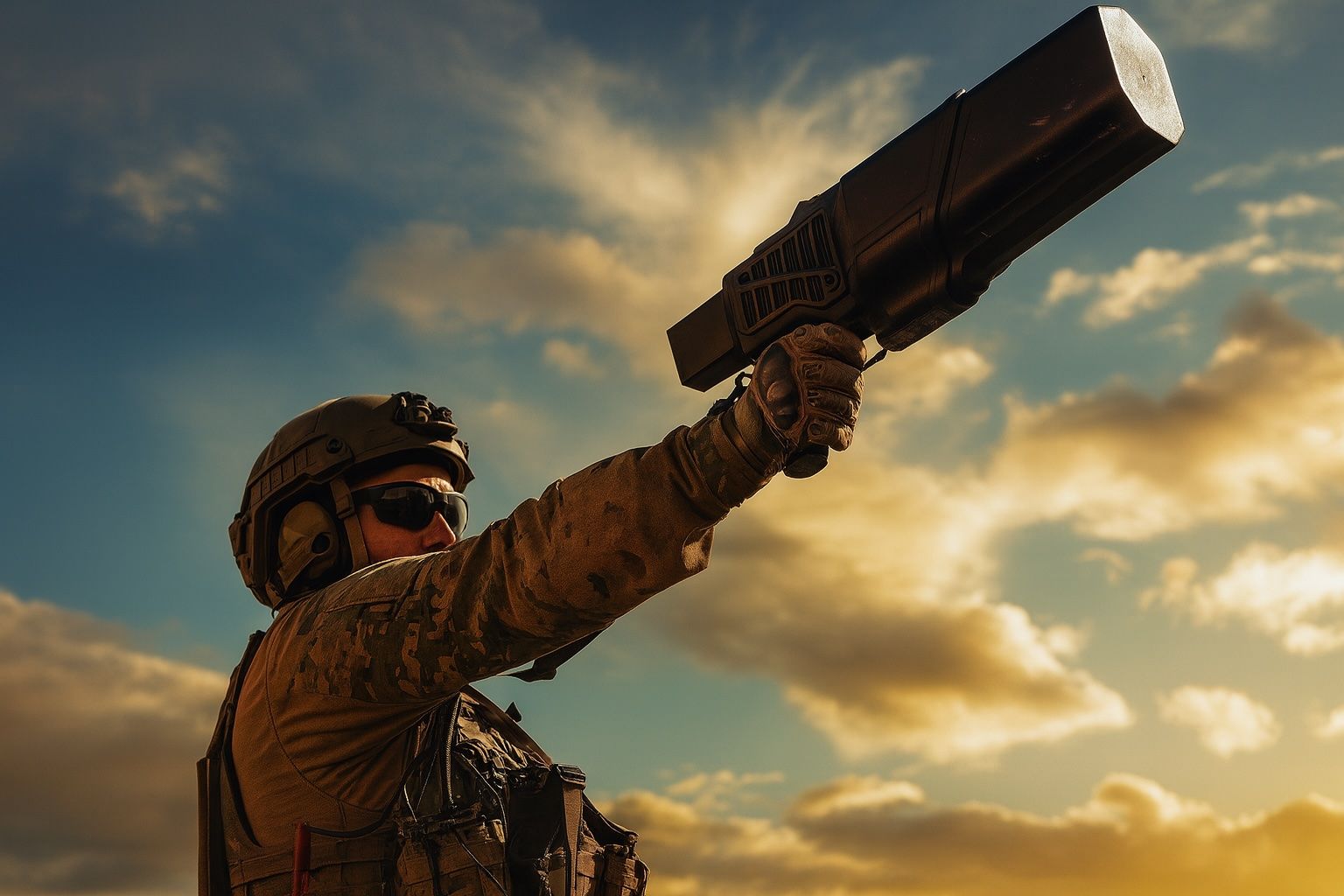- A spectacular run followed by a steep fall. Australian defence‑technology company DroneShield saw its share price surge more than 577 % year‑to‑date and over 65 % in the month of September 2025. However, the stock crashed 19 % on 2 October 2025, with the ASX‑listed shares plunging 9.76 % as investors locked in profits [1] [2]. The move sparked talk of a “mega crash” in one of the year’s hottest defence stocks.
- Why the stock was hot. Demand for anti‑drone technology has boomed due to geopolitical tensions. DroneShield develops counter‑UAS systems used in defence, law enforcement and critical infrastructure, and the company’s sales momentum and high-profile orders from the U.S. Department of Defense fuelled a rally. This performance turned DroneShield into a market darling, pushing the stock to unsustainable valuations [3] [4].
- Profit‑taking amid sky‑high valuations. Analysts warned that DroneShield traded on price‑to‑earnings ratios above 100 and a price‑to‑sales ratio around 40, far higher than defence peers [5]. Some investors heeded those warnings and took profits, triggering the October sell‑off. Despite the fall, the company’s fundamentals still look promising: revenue growth is strong and orders continue to come in [6].
- Expansion into the U.S. and contracts with the Pentagon. DroneShield announced a significant expansion of its research and development operations in the United States. The company plans to double its American workforce, prioritising software, artificial intelligence and a new facility in Virginia to meet growing demand [7]. Around the same time, it secured two contracts worth US$7.9 million for handheld counter‑drone systems from the U.S. Department of Defense, taking total deliveries past 4,000 units [8].
- EU builds a ‘drone wall’. In response to Russian incursions into Polish airspace and drone sightings near airports across Europe, the European Union launched an ambitious “drone wall” along its eastern flank. The project prioritises detection and includes radars, acoustic sensors, signal jammers and interceptors, with the goal of creating a layered system to identify, track and neutralise hostile drones [9] [10]. Nine frontline member states are participating, and Ukraine is invited due to its expertise in drone production [11].
- Europe’s fear of unpreparedness. Recent drone incursions at airports in Poland, Denmark and Sweden exposed Europe’s limited preparedness; officials warn that anti‑drone capability is now an “immediate priority” for national security [12] [13]. The drone wall is part of the EU’s broader Readiness 2030 program to modernise defence and deter Russian aggression [14].
- Robust revenue growth despite volatility. DroneShield posted 210 % year‑on‑year revenue growth in the first half of 2025, with a sales pipeline of US$2.33 billion across more than 40 countries and over 4,000 systems deployed [15]. The company invests more than US$50 million annually into research and development, focusing on AI‑powered detection and defeat systems [16].
- Benchmark for momentum stocks. Semiconductor equipment maker ASML exemplifies the broader tech rally. After delivering strong earnings and benefiting from the AI boom, ASML shares have held at high levels following a surge; analysts in a chart‑tracking report note that the stock remains near record highs, but volatility persists [17]. The experience of DroneShield shows how quickly momentum stocks can reverse when investors perceive valuations as stretched [18].
The Rise and Fall of DroneShield’s Stock
DroneShield, headquartered in Sydney, specialises in technologies that detect and defeat unmanned aerial systems. Its DroneGun and DroneSentry products combine radar, radio‑frequency sensors and signal jamming to intercept drones without kinetic damage. Over the past year, geopolitical conflicts and high‑profile drone attacks have driven governments and critical infrastructure operators to invest heavily in counter‑UAS solutions. DroneShield responded by signing new contracts, including two U.S. Department of Defense orders worth US$7.9 million, which pushed its total deliveries above 4,000 systems [19]. Investors interpreted these contracts as validation of the firm’s technology and future revenue potential.
With demand surging, DroneShield’s shares rallied spectacularly through 2025. In late September, the stock jumped more than 23 % in a single day as momentum traders piled in, bringing year‑to‑date gains to 577 % [20]. The run‑up was fuelled by speculation that the company could become a leading global supplier of counter‑drone systems amid rising geopolitical tensions. Analysts at Finanzen.net noted that despite a lack of fresh company announcements, investors believed “momentum” would continue as defence budgets expanded [21]. Yet only days later, shares plunged 19 %, signalling that traders were locking in profits and perhaps reacting to the company’s rich valuation. The decline underscores how quickly momentum can reverse when sentiment shifts.
Why Anti‑Drone Technology Is in High Demand
Modern warfare and national security strategies increasingly depend on unmanned aerial vehicles for surveillance, intelligence and attack. At the same time, commercially available drones have created new threats to airports, prisons and public events. DroneShield’s technology addresses both civil and military markets: its systems use sensors to detect a drone’s radio signature, then employ jamming or other non‑kinetic measures to disable the aircraft [22]. The company sells handheld devices like the DroneGun MKII and integrated systems such as DroneSentry to governments, law‑enforcement agencies and infrastructure operators globally.
The surge in orders over the past year is partly due to geopolitical conflicts. Russia’s war in Ukraine has demonstrated the effectiveness of drones for reconnaissance and strike missions, while attacks on oil facilities and airports in the Middle East highlight the potential for sabotage. Western militaries see counter‑UAS capability as essential, and NATO’s Project FlyTrap has tested systems from multiple vendors; DroneShield executives emphasise that such exercises allow the technology to be trialled under combat conditions [23]. With more than 40 countries using its products, DroneShield had accumulated a US$2.33 billion pipeline by mid‑2025 and expects robust demand to continue [24].
Fundamentals and Valuation Concerns
While orders continue to pour in, DroneShield’s valuation has raised eyebrows. A Wallstreet‑online analysis observed that the company traded on a price‑to‑earnings ratio exceeding 100 and a price‑to‑sales ratio around 40, far higher than most defence peers [25]. Such lofty multiples imply that investors expect extraordinary growth. Indeed, revenue jumped 210 % year‑on‑year in the first half of 2025 and is forecast to climb over 110 % the following year, compared with an industry average of 17 % [26] [27]. Bulls argue these numbers justify the premium.
Still, high valuations leave little margin for error. Simply Wall St analysts note that the company’s price‑to‑sales ratio of 35.9 times implies investors are pricing in aggressive revenue growth far into the future [28]. Wallstreet‑online cautions that profit‑taking is rational given the stock’s run‑up and that fundamentals have not yet caught up [29]. After the October drop, the stock traded around A$5.18 on the ASX and €2.90–3.70 in Europe, still well above its levels at the start of the year [30].
Europe’s ‘Drone Wall’ and Rising Tensions
The European Union’s plan to create a “drone wall” illustrates how governments are racing to respond to the evolving drone threat. In September 2025, Russian surveillance drones violated Polish airspace and triggered public alarm. EU Commissioner Andrius Kubilius called for an immediate priority to protect Europe’s eastern flank, and defence ministers from nine frontline countries met in Berlin to move the project from discussion to action [31]. The initiative is part of the Eastern Flank Watch project and aims to integrate radars, acoustic sensors, signal jammers, interceptors and artillery pieces to detect and neutralise hostile drones [32].
The drone wall has both symbolic and practical significance. The EU expects the system to deter Russia and reassure member states that the bloc can protect its airspace. Participating countries include Poland, Finland, Estonia, Latvia, Lithuania, Norway, Sweden, Germany, Slovakia and Ukraine [33]. Ukraine, which reportedly has the capacity to produce four million drones annually, offers expertise in manufacturing and deployment. Officials emphasise that detection is the first priority but that effective means of destruction must also be developed [34]. The initiative underscores that Europe has historically lacked preparedness: recent drone sightings near airports in Poland, Denmark and Sweden exposed gaps in air‑defence systems [35]. The program is linked to the Readiness 2030 agenda, which seeks to expand EU defence policy and funding [36].
ASML and the Broader Tech Rally
While defence stocks like DroneShield have captured headlines, semiconductor equipment provider ASML exemplifies the broader technology rally. The company supplies advanced lithography machines essential for manufacturing leading‑edge chips used in smartphones, datacentres and artificial intelligence. A chart‑tracking report notes that ASML’s shares are holding their elevated levels after a rally, while other momentum names such as Siemens and Vertiv hover near record highs [37]. Analysts caution that these stocks remain volatile; they can deliver significant returns but also experience sudden reversals similar to DroneShield’s crash.
The AI boom has increased demand for advanced chips, benefiting ASML. However, economic headwinds and trade restrictions can influence orders. Investors who rode the wave in 2025 must weigh the sustainability of growth against elevated valuations and geopolitical risks. The experience of DroneShield serves as a reminder that momentum‑driven rallies can quickly falter when the market questions underlying fundamentals [38].
Final
DroneShield’s rapid rise and subsequent drop illustrate both the opportunities and risks in the defence‑technology sector. Demand for anti‑drone systems is surging as conflicts and drone incursions make counter‑UAS capability an essential part of national security. The company’s expansion into the U.S. and its large sales pipeline suggest strong long‑term prospects. Yet the October crash underscores that valuation matters: sky‑high multiples invite profit‑taking and volatility. Meanwhile, the EU’s ambitious drone wall and the ongoing AI‑driven tech rally show that investors should monitor how geopolitics, regulation and innovation shape markets. In a world where drones and chips influence both security and commerce, careful analysis of fundamentals and context is crucial.
References
1. www.finanzen.net, 2. www.wallstreet-online.de, 3. www.finanzen.net, 4. www.fool.com.au, 5. www.wallstreet-online.de, 6. www.streetwisereports.com, 7. www.fool.com.au, 8. www.proactiveinvestors.com, 9. www.euronews.com, 10. www.defensenews.com, 11. www.euronews.com, 12. www.euronews.com, 13. www.defensenews.com, 14. www.euronews.com, 15. www.streetwisereports.com, 16. www.streetwisereports.com, 17. stock3.com, 18. simplywall.st, 19. www.proactiveinvestors.com, 20. www.finanzen.net, 21. www.finanzen.net, 22. www.proactiveinvestors.com, 23. www.streetwisereports.com, 24. www.streetwisereports.com, 25. www.wallstreet-online.de, 26. www.streetwisereports.com, 27. simplywall.st, 28. simplywall.st, 29. www.wallstreet-online.de, 30. www.finanzen.net, 31. www.defensenews.com, 32. www.euronews.com, 33. www.euronews.com, 34. www.euronews.com, 35. www.euronews.com, 36. www.euronews.com, 37. stock3.com, 38. simplywall.st







